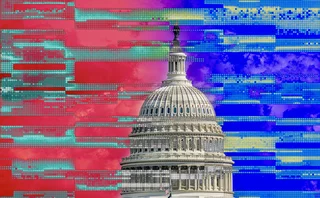Industry participants: ‘Digital Token Identifier’ aims to increase interop, usage
While some trading firms are welcoming the use of a new non-proprietary code for identifying digital tokens, the onus will be on local regulators to enforce its adoption.

At a time when the crypto world is in disarray, some market participants believe identifiers and standards can offer a shred of stability—or at least that’s the hope.
Identifiers are tools used in traditional markets to identify a security and provide some form of commonality and harmony to the complex world of trading and regulatory reporting. Now, in the European Union, those same traditional tools are being applied to cryptocurrencies.
The European Securities and Markets Authority (Esma) has recommended the use of Digital Token Identifiers for trading and reporting digital assets. The DTIs are identification codes developed by the DTI Foundation (DTIF), a non-profit trading division of Etrading Software, and are based on the standards set out by the International Organization for Standardizations (ISO) for digital assets.
The endorsement of the use of DTIs is part of the European Commission’s wider Distributed Ledger Technology (DLT) Pilot regulatory regime, a program that aims to develop the trading and settlement of tokenized securities (i.e., digital representations of traditional securities when using DLT) and enable both regulators and market participants to better understand the potential issues that could emerge with the use of DLT while maintaining financial stability. The pilot regime commences this year on March 23.
Primary issuers should work towards the assets they issue being ‘un-locked’ and adhering to a common framework of digital token identifiers. This will ensure that the asset can be supported by a wide range of market solutions
Duncan Trenholme, TP Icap
There is hope that the use of DTIs will prevent issues such as overconcentration or vendor lock-in with DLT-based market structure firms or a single DLT technology provider.
“Users of tokenized securities want to ensure there is no lock-in, that there is no individual blockchain that they must use just because a bond has been issued on it,” says Sassan Danesh, CEO of Etrading and founding member of the DTIF.
“They want to have flexibility as the technology matures, because of course it’s still very early days. And that maturing of the technology might mean that other blockchains become more prominent in the future.”
Market participants, like Danesh, believe DTIs could provide a helping hand in driving interoperability between DLT platforms that support the issuance, trading, and settlement of tokenized financial instruments. He sees this as critical in reducing third-party risk and overreliance on a single DLT-based vendor or market operator. Concentration risk has become particularly important in the wake of recent events in crypto and DLT. User confidence in these types of products and technologies is at an all-time low.
Esma sees the use of DTIs as a mechanism for monitoring trading activity in financial instruments across DLT platforms, for better identifying market abuse, and for mitigating risks associated with third-party concentration.
“The use of DTIs can be used to aggregate market data from each chain and across all chains, thus enhancing interoperability among different DLT platforms. In this sense, it could be considered as a tool to mitigate the risks outlined,” a spokesperson at Esma tells WatersTechnology.
Costs and common ground
The hope is that the introduction of new identifiers to represent digital tokens that is operated by a non-profit organization—and, more importantly, that is free of charge—will help bring stability to the world of institutional crypto trading.
Rudolf Siebel, managing director at BVI, the German fund and asset management trade association, believes there is a high risk in using and promoting proprietary identifiers created and managed by private companies. Rather, he supports ISO-accredited standard identifiers that are free to use—outside of the implementation costs.
“There is the risk of license fees—so we would like to see the global use of the DTI,” he says.
Siebel points to another problem with using unstandardized proprietary symbols for describing digital assets. In cryptocurrencies, some exchanges such as Nasdaq use the symbol BTC for bitcoin, whereas others use the ISO-supported XBT symbol. This has led to inconsistency across the asset class and creates a litany of new challenges for users and regulators when trying to track the different symbols.
Similarly, Duncan Trenholme, co-head of digital assets at TP Icap, also welcomes the use of ISO-standard DTIs. He says common standards will drive growth in the market and enable these products to be transferable and fungible between different DLT systems operated by financial market infrastructures (FMIs). The problem arises when digital exchanges, custodians, and clearing and settlement houses are supported by vastly different DLTs that don’t speak to one another. Trenholme says FMIs and banks need to think carefully about what DLT they commit to.
“Should a digital exchange decide to implement its own version of a chain, there’s a significant risk of isolation as this is not a settlement system supported by any other market participants,” he says.
“Further, primary issuers should work towards the assets they issue being ‘unlocked’ and adhering to a common framework of digital token identifiers. This will ensure that the asset can be supported by a wide range of market solutions, whether for custody or exchange, as long as they support the blockchain or DLT of issuance and recognize the digital identifiers.”
The idea is that if FMIs use common technologies and standards, this should provide investors with flexibility and choice—such as moving their assets to the trusted custodian that fits their risk profile, or seeking liquidity on multiple digital exchanges.
“Without this, their portfolio is at risk of becoming fragmented, locked onto a single digital platform, and unable to be transferred elsewhere, which will hinder best execution and price discovery,” Trenholme says.
Rob Cranston, global head of equities products at Liquidnet, likens the use of identifiers and common standards to the growth of electronic trading in the equities market. He says common languages and protocols such as the Fix protocol are necessary for markets to thrive.
“When Fix came in as a protocol, you were then able to have a common language between systems that allowed them to talk. There were a whole bunch of competing protocols at the time and a whole bunch of different ways of doing things [but Fix helped lead] to this explosion of the electronification in the equities market,” Cranston says.
“It was not the only factor, to be clear, but it was an important one because you needed a common nomenclature.”
Adoption and enforcement
But with any identifier there is always the concern that adoption could be low. Even though Esma has recommended the use of the DTI by market infrastructure firms, there is still no mandate for them to use it or for individual national competent authorities (NCAs) to enforce its implementation.
ETrading's Danesh says despite that, he has received some assurances from Esma of its adoption and use.
“One of the questions we asked Esma was about the circumstances of a recommendation not being followed through by individual national competent authorities. What we were told was that this recommendation is in the context of an exception to the regulatory reporting requirements. In other words, as a compensatory measure for not having regulatory reporting in place, Esma recommends the use of the DTI. In our mind, this is a strong rationale for the go-ahead, and we are reassured the DTI will be used,” he says.
As part of the DTI drive, the DTIF will work with individual NCAs to explain how the identifier codes can be used and written into their individual national rule books.
“These are very technical topics we would help them with, [such as] the way they would update their rule book or… where does the DTI go when reporting?” Danesh says.
The DTI standard is continuing to grow and capture new tokenized assets. One that is currently under review and being discussed is the inclusion of non-fungible tokens—widely known as NFTs. To date, the foundation has issued ISO-identification codes for more than a thousand of the most-traded digital assets.
Other efforts being led by the DTIF include bridging traditional identifiers with the newly created crypto asset identifiers. The foundation is working with the Global Legal Entity Identifier Foundation (Gleif) to map the financial instrument, in this case, the digital asset and its DTI, with the company issuing and its LEI. This is similar to how LEIs are mapped to Isins, where a regulator can see which company (via its LEI) is issuing, trading, or reporting which securities (via their Isin).
“Market participants and public authorities will be able to follow the provenance of the DTI and see who the issuer is. The authorities will also be able to see where risk is being aggregated and the LEIs play a significant role in understanding what company has that risk,” Danesh says.
But mapping the LEI to DTIs is still in its early days, says Stephane Wolf, CEO of Gleif. There remains a lot of uncertainty as to how regulators will tackle the world of crypto. It is yet to be seen whether the EU lawmakers will amend existing regulations, such as the Markets in Financial Instruments Directive II, to incorporate DLT and digital tokens, while at the same time the industry is still awaiting the roll-out of an extensive set of rules—coming into force in 2024—known as the Markets in Crypto Assets Regulation, which is aimed at promoting the use of and innovation in crypto assets while securing the protection of consumers.
Wolf says there are currently a lot of unknowns regarding how the crypto space will be regulated and thus how digital token identifiers will progress. And ultimately, the power—i.e., enforcement—sits with the regulators.
“We believe that every intermediary, every exchange, every issuer, everyone that has a legal entity background should have an LEI and report its LEI activities in the digital asset space,” Wolf says. “How this has been perceived by regulators or how they utilize this for new regulation, that’s a different story. We never interfere with policy-making. That’s not our job—it’s solely their responsibility.”
Only users who have a paid subscription or are part of a corporate subscription are able to print or copy content.
To access these options, along with all other subscription benefits, please contact info@waterstechnology.com or view our subscription options here: http://subscriptions.waterstechnology.com/subscribe
You are currently unable to print this content. Please contact info@waterstechnology.com to find out more.
You are currently unable to copy this content. Please contact info@waterstechnology.com to find out more.
Copyright Infopro Digital Limited. All rights reserved.
As outlined in our terms and conditions, https://www.infopro-digital.com/terms-and-conditions/subscriptions/ (point 2.4), printing is limited to a single copy.
If you would like to purchase additional rights please email info@waterstechnology.com
Copyright Infopro Digital Limited. All rights reserved.
You may share this content using our article tools. As outlined in our terms and conditions, https://www.infopro-digital.com/terms-and-conditions/subscriptions/ (clause 2.4), an Authorised User may only make one copy of the materials for their own personal use. You must also comply with the restrictions in clause 2.5.
If you would like to purchase additional rights please email info@waterstechnology.com
More on Regulation
Off-channel messaging (and regulators) still a massive headache for banks
Waters Wrap: Anthony wonders why US regulators are waging a war using fines, while European regulators have chosen a less draconian path.
Banks fret over vendor contracts as Dora deadline looms
Thousands of vendor contracts will need repapering to comply with EU’s new digital resilience rules
Chevron’s absence leaves questions for elusive AI regulation in US
The US Supreme Court’s decision to overturn the Chevron deference presents unique considerations for potential AI rules.
Aussie asset managers struggle to meet ‘bank-like’ collateral, margin obligations
New margin and collateral requirements imposed by UMR and its regulator, Apra, are forcing buy-side firms to find tools to help.
The costly sanctions risks hiding in your supply chain
In an age of geopolitical instability and rising fines, financial firms need to dig deep into the securities they invest in and the issuing company’s network of suppliers and associates.
Industry associations say ECB cloud guidelines clash with EU’s Dora
Responses from industry participants on the European Central Bank’s guidelines are expected in the coming weeks.
Regulators recommend Figi over Cusip, Isin for reporting in FDTA proposal
Another contentious battle in the world of identifiers pits the Figi against Cusip and the Isin, with regulators including the Fed, the SEC, and the CFTC so far backing the Figi.
US Supreme Court clips SEC’s wings with recent rulings
The Supreme Court made a host of decisions at the start of July that spell trouble for regulators—including the SEC.







